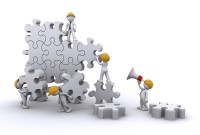- Home
- Business Processes
- Industry Knowledge
- Aerospace Industry
- Automotive Industry
- Banking Domain
- BFSI Industry
- Consumer/ FMCG Industry
- Chemicals Industry
- Engineering & Construction
- Energy Industry
- Education Domain
- Finance Domain
- Hospitality Domain
- Healthcare Industry
- Insurance Domain
- Retail Industry
- Travel and Tourism Domain
- Telecom Industry
- Leadership Skills
- eLearning
- Home
- Leadership Skills
- Leadership & Management
- Taylor’s Scientific Management
Taylor’s Scientific Management
Taylor’s theory of scientific management aimed at improving economic efficiency and labor productivity. Taylor had a simple view that money motivated people at work. He felt that workers should get a fair day's pay for a fair day's work, and that pay should be linked to the amount produced. He introduced the differential piece rate system, of paying wages to the workers.
The industrial revolution provided the impetus for developing various new approaches to increase the productivity and efficiency of the workers. Taylor during 1856 and 1915 propounded that there is a need for developing a scientific way of performing each job and workers should be trained to perform that particular job in a scientific way. Harmonious relations should be developed between management and workers to ensure that the job is performed in the desired way. This led to the management theory known as principles of scientific management.
This theory is a Classical management theory that is based on the belief that workers only have physical and economic needs and prescribes specialization of labor. Classical theories recommend centralized leadership and decision-making and focus on profit maximization. Three streams of classical management theory are - Bureaucracy (Weber), Administrative Theory (Fayol), and Scientific Management (Taylor).
Principles of Scientific Management
Four Principles of Scientific Management are:
- Time and motion study: Develop a science for each element of the job to replace the old rule of the methods. Study the way jobs are performed and find new ways to do them.
- Training: Scientifically select employees and then train them to do the job as described in step-1. Teach, train, and develop the workman with improved methods of doing work. Codify the new methods into rules.
- Supervision: Interest of employer & employees should be fully harmonized so as to secure mutually understanding relations between them. Supervise employees to make sure they follow the prescribed methods for performing their jobs. Continue to plan the work but use workers to actually get the work done.
- Differential Rewards: Establish fair levels of performance and pay a premium for higher performance.
Taylor's scientific approach resulted in a piece-rate incentive system, and the time-and-motion study.
Taylor's Differential Piece Rate Plan:
Taylor felt that the wage system was one of the major reasons for soldiering. To resolve this problem, he advocated the use of a piece-rate incentive system. The aim of this system was to reward the workers who produced the maximum out-put. The system proposed:
- If Efficiency is greater than the defined Standard then workers should be paid 120 % of the Normal Piece Rate.
- If Efficiency is less than standard then workers should be paid 80% of the Normal Piece Rate.
Time and Motion Study:
Taylor also tried to determine the best way to perform each and every job. To achieve this objective, he introduced a method called time-and-Motion study. In this method, a large production job was broken down into various small tasks or motions and unnecessary motions were removed to find out the best way of doing a job. A motion study involves finding out the best sequence and the minimum number of motions needed to complete a task.
After Taylor, Frank and Lillian Gilbreth made numerous contributions to the concepts of scientific management. Frank and Lillian were mainly involved in exploring new ways of eliminating unnecessary motions and reducing worker fatigue.
- Frank Gilbreth (1868-1924) is considered the "father of motion study"
- Lillian Gilbreth (1878-1972) contributed to studies pertaining to motion.
Limitations of Scientific Management:
Although Scientific Management Theory has been instrumental in providing various valuable insights into the development of management thought. In spite of the numerous contributions made by scientific theory, given below are the few limitations:
- The principles of scientific management focus on solutions from an engineering point of view rather than a managerial point of view
- The entire theory is based on the assumption that humans are rational and motivated primarily by the desire for material gain. It overlooks the social and emotional needs of workers and overstressed their economic and physical needs
- The human desire for self-actualization and job-satisfaction (working conditions, job content, etc.) is ignored by the theory
Suggested Reading and Resources
Related Links
You May Also Like
-
Power is the ability to exercise influence or control over others. Leadership involves authority and it is very important for leaders to understand what type of power they're using. The 5 Types of Power in Leadership are Coercive power, expert power, legitimate power, referent power, and reward power. Authority is the right to command and extract obedience from others. It comes from the organization and it allows the leader to use power.
-
Managers have to perform many roles in an organization, and how they handle various situations will depend on their style of management. Management styles are the characteristic ways, of making decisions relating to subordinates. These are the strategies, efforts, or direction used by the manager, to create an efficient workplace, to achieve organizational goals. A management style is the method of leadership used by a manager.
-
In today's business world, proficiency in management skills is essential for career growth and success. Managerial skills can be defined as attributes or abilities that are essential for every leader and manager to succeed and fulfill specific tasks expected from them by the organization.
-
In this study of power, Raven identified five bases of power as coercive, reward, legitimate, referent, and expert. The 5 Types of Power can help you decide when it is appropriate to use a particular type of power in important situations. Leadership involves authority and it is very important for leaders to understand what type of power they're using.
-
The ten most important qualities that define a good leader are self-awareness, interpersonal and communication skills, ethical values, organizational consciousness, self-confidence, adaptability and flexibility, imagination and creativity, focus & result-orientation, continuous self-development and accountability and ownership for his actions. These ten qualities of leadership every good leader should possess to a certain extent and must continually strive to develop them.
-
Behavioral Approach to Management
The behavioral management theory had a profound influence on management by focusing on understanding the human dimensions of work. It is also called human relations movement as behavioral theorists focused on managing productivity by understanding factors of worker motivation like their needs and expectations, personality, attitudes, values, group behavior, conflict, and group dynamics. It advocated the use of psychological techniques to motivate employees.
-
Management theories are the recommended management strategies that enable us to better understand and approach management. Many management frameworks and guidelines were developed during the last four decades.
-
Emergent leadership occurs when a group member is not appointed or elected as leader, but rather that person steps up as the leader over time within-group interactions. Have you ever faced challenges in getting accepted into your new role of position as a leader? Groups don't automatically accept a new "boss" as a leader. Emergent leadership is what you must do when taking over a new group. Learn more about emergent leadership.
-
What are the functions which a leader does to establish as a leader? What are the activities undertaken by them to become great leaders, rather revolutionary leaders? The most important tasks done by a leader in all situations are defining the vision, mission, and goals, leading the team, administrative functions, motivating followers, decision making and conflict resolution, and continuous development.
-
Leadership has been defined in different ways by different sets of scholars. In very simple terms leadership can be defined as the skill of a person to influence an individual or a group for achievement of a goal in a given situation. One can use different dimensions and perspectives to define leadership. Through the evolution of leadership thought, leadership has been defined in various ways discussed here.
Explore Our Free Training Articles or
Sign Up to Start With Our eLearning Courses

About Us
Learning
© 2023 TechnoFunc, All Rights Reserved










